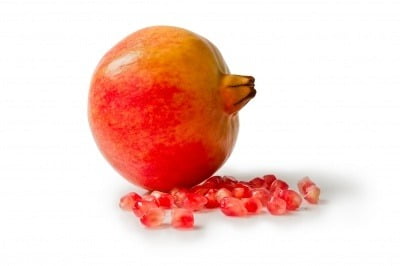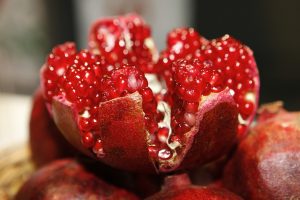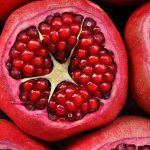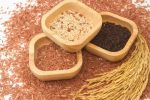
Overview
The ancients were fascinated by the pomegranate. The hard rather unappealing horny peel hides the seeded rubies that lie embedded in crystal red blood. It symbolised rebirth. In mythology, the ancient Egyptians buried pomegranates believing in its association with being reborn and hence continuing in the afterlife. In Greek myths, Persephone, the daughter of Demeter accepted six seeds of the fruit from Hades in a similar level of belief. She was then forced to reside in the Underworld for half the year before reappearing — a symbol of nature renewing itself. Likewise, the fruit has renewed its popularity in Western cultures because both fusion and Persian restaurants offered exotic cuisine where it played its part in sweetening a variety of meat dishes. This sensory element has never been missing from cooking throughout the Middle East to India. The fruit has always been served in this region as a common accompaniment to meats such as lamb in tagines, providing a soft drying and sweet flavour to the stewed meat.
The French called it ‘grenade’ and it lent its name to the hand held device whose size, shape and insides resemble the fruit. Grenadine is the liqueur based on the juice.
The quality of the fruit depends on its state of ripening. The older the fruit, the better the quality in terms of colour and nutrients of the fruit and juice. Its rind also protects it for about 3 to 4 weeks at room temperature. The easiest way to sample this fruit is to cut in half, scoop out the seeds without causing too much or use a toothpick to prize out each one as this is less messy but more time consuming.
Compounds In Pomegranate
Analysis of the juice shows it to contain a number of anthocyanins, principally 3-glucosides, the 3,5-diglucosides of delphinidin, cyanidin and pelargonidin (Du et al., 1975). Its acidity is 1g/L citric acid monohydrate with a vitamin C content of 7 mg/L (ascorbic acid) (El-Nemr et al., 1990). The other parts of the plant such as bark and leaf contain large amounts of ellagitannins and gallotannins – (Tanaka et al., 1985, 1986a & b; Nawwar et al., 1994). The peels contain punicalagin which might prove to be highly beneficial in treating various conditions including diabetes discussed later.
If the fruit husk and leaves could also be incorporated as part of the juice extraction, then a number of other components might be obtained to supplement the juice such as apigenin and the luteolin glycosides besides punicalagin (Nawwar et al., 1994).
Nutritional Benefits
Pomegranate juice has a very high antioxidant capacity which on a weight basis is higher than acai berry juice, cranberry juice, grape juice, green tea and red wine. It is felt that drinking this juice helps reduce oxidative stress by mopping up free radicals in the body. This high antioxidant potential is linked to other benefits mentioned below.

-Heart Health & Cancer
The fruit has been linked to heart health as in reducing blood pressure and inflammation, and treating certain types of cancers.
– Inflammatory Diseases
The juice has shown a positive impact in treating inflammatory disease by suppressing basophil and mast cell activation (Rasheed et al. 2009) and then in treating arthritis by reducing the impact on cartilage damage through a reduction in inflammation (Rasheed et al., 2010).
-Diabetes
Type-2 diabetes (diabetes mellitus) is seen as a growing menace of the burgeoning world population particularly as lifestyles become more affluent. One issue linked to diabetes is liver damage.
A study in diabetic mice has shown that punicalagin extracted from pomegranate peel could reduce what is termed endoplasmic reticulum (ER) in the cells of the liver. Researchers in various Chinese universities gave these diabetic rats punicalagin and after five weeks treatment examined their blood and liver samples. The critical features were that punicalagin minimised both insulin and glucose resistance in liver cells as well as improving insulin sensitivity. The components also reduced free fatty acid levels and the incidence of fatty liver (hepatic steatosis). There is also a genetic element where punacalagin down-regulated various markers for stress associated with stress of the ER in liver cells (Mo et al., 2019).
To take advantage of punicalagin in the peels would mean doing some type of water extraction to remove this component and then adding it to the pomegranate juice .
EFSA Claims
It has also been the subject of recent scientific opinion whereby its health claims were assessed by EFSA (2010). Much of the evidence was based not only the fruit but on its two principal components punicalagin and ellagic acid. Six claims were made to EFSA for the the fruit and its juice but they would not endorse the view that consumption of the fruit, the juice, punicalagin or ellagic acid found in either helped maintain normal blood cholesterol concentrations, could maintain normal erectile function in men, would protect lipids from damage, provided an antioxidant benefit including one for anti-aging, be helpful in maintaining normal blood glucose concentrations or help to improve appetite following weight loss. The main studies for reference were for oxidative stress (Aviram et al., 2000), lipid metabolism (Esmaillzadeh et al., 2004, 2006); impotence (Forest et al., 2007); absorption (Mertens-Talcott et al., 2006; Seeram et al., 2006; Rosenblatt et al., 2006). Most failures in opinions were the result of providing too little evidence in studies of a poorly defined and uncontrolled nature, often with too small a sample size, and it will have irked those agencies promoting the fruit and its juice. There are other disease states under scrutiny which have not been assessed yet by EFSA e.g. a reputed benefit on prostate cancer (Malik et al., 2004).
Brands
So what now for pomegranates, because evidence for its beneficial properties continues to be acquired and it does make for a pleasant tasting drink. One brand, PomWonderful ™ began to make its mark worldwide as a way of exploiting the nutritional properties of its juice. It is highly palatable as a 100% juice product. Sirco ™ also offers a 100% fruit-based product mixing pomegranate with orange juice with a heart health claim based on its trademarked tomato extract . Pomegranate is best described as having a juicy, red fruit flavour which is not overpowering and a distinctive drying, woody note due to its high polyphenol content. Having seen it used in a number of paintings in Rome, both historic and modern recently, it does present a highly attractive vision of a fruit which would naturally entice all of us, let alone Persephone.
Products
References
Aviram, M., Dornfeld, L., Rosenblat, M., Volkova, N., Kaplan, M., Colemann, R., Hayek, T., Presser, D., Fuhrman, B. (2000) Pomegranate juice consumption reduces oxidative stress, atherogenic modifications to LDL, and platelet aggregation: studies in humans and in atherosclerotic apolipoprotein E-deficient mice. Am. J. Clin. Nutr. 71, pp. 1062-1076.
Du, C. T., Wang, P. L., Francis, F. J. (1975) Anthocyanins of pomegranate, Punica granatum. J. Food Sci. 40, pp. 417-418.
EFSA (Agostoni, C.V.) (2010) Scientific Opinion on the substantiation of health claims related to pomegranate/pomegranate juice and maintenance of normal blood cholesterol concentrations (ID 1162, 1320, 2107, 2167), maintenance of normal erectile function (ID 1163), protection of lipids from oxidative damage (ID 1201, 1319, 2123), “antioxidant and anti-aging properties” (ID 1901), increase in appetite after unintentional weight loss leading to an increase in energy intake (ID 2122) and maintenance of normal blood glucose concentrations (ID 4471) pursuant to Article 13(1) of Regulation (EC) No 1924/2006
EFSA Journal 8(10) pp. 1750 https://doi:10.2903/j.efsa.2010.1750
El-Nemr, S. E.; Ismail, I. A.; Ragab, M. (1990) Chemical composition of juice and seeds of pomegranate fruit. Nahrung 7, pp. 601-606.
Esmaillzadeh, A., Tahbaz, F., Gaieni, I., Alavi-Majd, H. and Azadbakht, L., (2004) Concentrated pomegranate juice improves lipid profiles in diabetic patients with hyperlipidemia. J. Medicinal Food, 7, pp. 305-308.
Esmaillzadeh, A., Tahbaz, F., Gaieni, I., Alavi-Majd, H. and Azadbakht, L. (2006) Cholesterol-lowering effect of concentrated pomegranate juice consumption in type II diabetic patients with hyperlipidemia. Int. J. Vit. Nutr. Res. 76 pp. 147-151.
Forest, C.P., Padma-Nathan, H., Liker, H.R., (2007). Efficacy and safety of pomegranate juice on improvement of erectile dysfunction in male patients with mild to moderate erectile dysfunction: a randomized, placebo-controlled, double-blind, crossover study. Int. J. Impotence Res., 19, pp. 564-567.
Malik, A., Afaq, F., Sarfaraz, S., Adhami, V.M., Syed, D.N., Mukhtar, H. (2005) Pomegranate fruit juice for chemoprevention and chemotherapy of prostate cancer. Proc. Natl. Acad. Sci. USA. 102 pp. 14813 – 14818.
Mertens-Talcott, S.U., Jilma-Stohlawetz, P., Rios, J., Hingorani, L., Derendorf, H., (2006) Absorption, metabolism, and antioxidant effects of pomegranate (Punica granatum L.) polyphenols after ingestion of a standardized extract in healthy human volunteers. J. Agric. Food Chem., 54, pp. 8956-8961.
Mo, F-F., Lv, B-h., An, T., Miao, J-n. et al., (2019) Protecive mechanism of punacalagin against endoplasmic reticulum stress in the liver of mice with type 2 dianetes mellitus. J. Functional Foods. 56 pp. 57-64 https://doi.org/10.1016/j.jff.2019.03.006
Nawwar, M. A. M.; Hussein, S. A. M.; Merfort, I. (1994) Leaf phenolics of Punica granatum. Phytochemistry, 37, pp. 1175-1177.
Rasheed, Z., Akhtar, N., Anbazhagan, A.N., Ramamurthy, S., Shukla, M., Haqqi, T.M. (2009) Polyphenol-rich pomegranate fruit extract (POMx) suppresses PMACI-induced expression of pro-inflammatory cytokines by inhibiting the activation of MAP Kinases and NF-κ B in human KU812 cells. J Inflamm (Lond.)., 6 pp.1.
Rasheed, Z., Akhtar, N., Haqqi, T.M. (2011) Pomegranate extract inhibits the interleukin-1beta-induced activation of MKK-3, p38 alpha-MAPK and transcription factor RUNX-2 in human osteoarthritis chondrocytes. Arthritis Res. Ther. 12 R195.
Rosenblat M, Hayek T and Aviram, M. (2006) Anti-oxidative effects of pomegranate juice (PJ) consumption by diabetic patients on serum and on macrophages. Atherosclerosis, 187 pp. 363-371.
Seeram, N.P., Henning, S.M., Zhang, Y.J., Suchard, M., Li, Z.P. and Heber, D. (2006) Pomegranate juice ellagitannin metabolites are present in human plasma and some persist in urine for up to 48 hours. J. Nutr., 136 pp. 2481-2485.
Tanaka, T.; Nonaka, G. I.; Nishioka, I. (1985) Punicafolin, and ellagitannin from the leaves of Punica granatum. Phytochemistry 24, pp. 2075-2078.
Tanaka, T.; Nonaka, G. I.; Nishioka, I. (1986a) Tannins and related compounds. XL. Revision of the structures of Punicalin and Punicalagin, and isolation and characterization of 2-Galloylpunicalin from the bark of Punica granatum L. Chem. Pharm. Bull. 34, pp. 650-655.
Tanaka, T.; Nonaka, G. I.; Nishioka, I. (1986b) Tannins and related compounds. XLI. Isolation and characterization of novel ellagitannins, punicacorteins A, B, C and D and punigluconin from the bark of Punica granatum L. Chem. Pharm. Bull. 34, pp. 656-663.



Leave a Reply